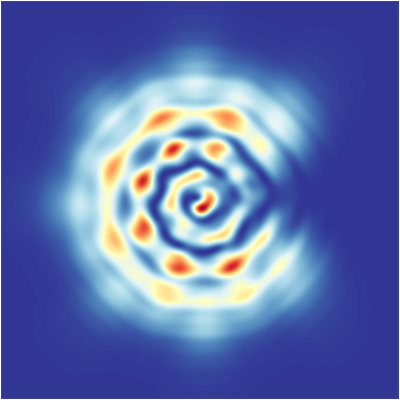Highlights
Reviewed: the emerging field of atomtronics
 In atomtronic circuits, ultracold atoms flow through guides made of laser light or magnetic fields, analogous to electrons zipping through conventional wires in electronic circuits. Image credit: Aki Honda, CQT
In atomtronic circuits, ultracold atoms flow through guides made of laser light or magnetic fields, analogous to electrons zipping through conventional wires in electronic circuits. Image credit: Aki Honda, CQT
CQT researchers have co-authored a review of the emerging field of atomtronics, which revolves around the manipulation of ultracold atoms to build circuits for devices. The concise and up-to-date summary of the field, which runs to 30 pages, is published in Reviews of Modern Physics on 18 November as a colloquium article.
In atomtronic circuits, ultracold atoms flow through guides made of laser light or magnetic fields, analogous to electrons zipping through conventional wires in electronic circuits. These atomtronic circuits can be harnessed for fundamental research, such as the study of quantum transport, and for applications such as quantum sensing, quantum simulation and quantum computing.
One of the big advantages of atomtronics devices compared to electronics devices is that their circuits could be easily reconfigured by reshaping the confining lasers or magnetic fields. “To me, atomtronics provides a futuristic platform for on-demand ‘electronic’ circuits on the fly,” says CQT Principal Investigator Kwek Leong Chuan, one of the co-authors of the paper. “We envisage that the realisation of ultracold interferometric circuits will give rise to new sciences and phenomena.”
The review has three main sections. One section covers the state-of-the-art optical and magnetic trapping technologies that support a variety of atomtronic circuits. Another section is devoted to coherent effects: millions of atoms behave as a single entity described by a single wavefunction in mesoscopic matter-wave circuits. The final section delves into the atomtronic components and applications that have been studied and developed so far. They include atomic qubit implementations and applications in sensing such as atomtronic quantum interference devices, the atomtronic equivalent of a Superconducting Quantum Interference Device which could be used to measure weak magnetic fields, and atomtronic interferometers, sensors with potential applications in inertial navigation and geophysics.
The review also presents an outlook of the field, suggesting potential research directions. For example, exploiting atomtronic circuits to tackle questions of high energy physics, exploring atomtronics as a platform for quantum gates by building on the demonstration of atomtronic qubits, and integrating atomtronic circuits with other existing technologies such as photonic and superconducting integrated circuits.
Kwek and CQT Visiting Research Professor Luigi Amico initiated the review in Singapore. They started working on atomtronics more than ten years ago. To write the review, Kwek and Luigi worked with collaborators Dana Anderson, Malcolm Boshier, Jean-Philippe Brantut, Anna Minguzzi and Wolf von Klitzing, who are based in France, Greece, Switzerland and the United States, and surveyed over 400 papers for the review.
“A pedagogical review is timely since there has been growing interest in this area coupled with beautiful experiments with atoms, both bosons and fermions, in toroidal optical traps,” Kwek says. “We thought it would be fantastic to initiate such a project to reach out to younger researchers who might be keen on the topic.”
The researchers met through the Atomtronics@Benasque conference workshops where some of them are organisers. The latest edition of the conference was held in May this year. Past editions of the conference have been held in 2015, 2017 and 2019.
Learn more
Related Stories
 | Simulation of superfluid atom rings paves way for experiments May 03 2018 |
 | An in-depth review of algorithms for noisy quantum computers February 16 2022 |






